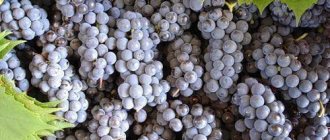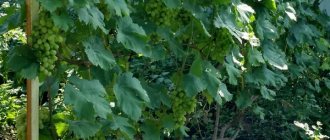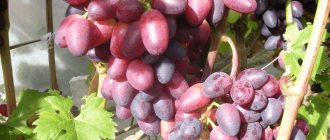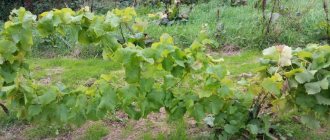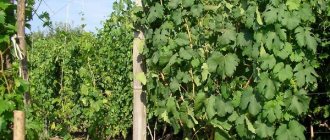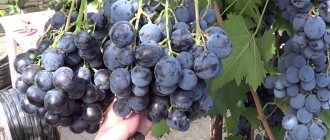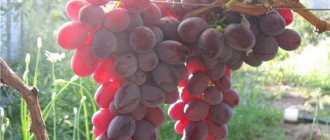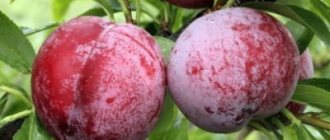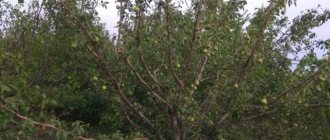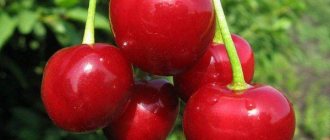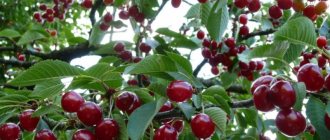General facts about the Shahinya variety
It is difficult to establish who its breeder is and which varieties can be called parental.
The main hypothesis is the result of amateur selection from sunny Tajikistan, where it is called Kizyl uzum kanibadamskiy, it can also be called Early Rizamat, Glory of Moldova. According to technical indicators, the variety should not be classified as high-quality grapes
Even taking into account the fact that, according to technical indicators, the variety should not be classified as high-quality grapes, the decision to grow Shahini is mainly based on its main advantage - its amazing appearance. The use of vines to decorate walls, gazebos, and hedges, which in the season are entwined with shoots and full clusters of bright pink color flaunting against their background, allows the owner, a lover of high aesthetics, to enjoy an unforgettable spectacle. The fruits are mainly used as a table delicacy; in regions of mass cultivation, pure and mixed compotes, juices, nectars, jams and confitures are industrially produced from it. I complement the bouquet of well-known vintage table wines with juice. Today, various online communities and virtual agricultural stores offer the purchase of many species subforms of this hybrid. Despite the fact that they can often be even slightly higher quality and have higher technical indicators than the base variety, you should take a closer look at the technical parameters of the base variety.
Capricious grapes with a ceremonial name - Shaheen of Iran
He has many names - among them are the Glory of Moldova, and Early Rizamat, Kizyl Uzyum Kanibadamsky.
However, most farmers do not agree with this - despite the amazing similarities, the real Shaheen of Iran, as they say, is somewhat different.
The variety, despite the “ceremonial” name and many names, is not considered a serious achievement in selection - in any case, it was not included in the register.
And, to be honest, the “queen”’s taste was disappointing - simple, bordering on primitive, grapey. In addition, you will have to literally protect this capricious girl from everything possible. What is its charm?
Criteria and features of Shahini
Perhaps this grape perfectly corresponds to its main name. Having this “special royal blood” in your garden will not make you bored. You will have to constantly work to protect it from cold, heat, disease, parasites, wasps, birds and other misfortunes. What is the “Iranian ruler” like?
- The grapes belong to the category of table varieties.
- It is characterized by early ripening, the berry is ready for harvest in mid-August, the ripening period is from 120 to 125 days, winegrowers consider the average date for harvesting to be August 15–18.
- The bushes are distinguished by strong and powerful growth, with shoots of a distinct brown hue and bright red nodes.
- The flowers are bisexual, self-pollination is present, which contributes to the preservation of the varietal qualities of the grapes. The leaf is dark green, round in shape and well cut.
- The clusters are attractive, cylindrical-conical, harmonious in shape, weighing on average 0.85–1.00 kg, but with proper care and good weather conditions it is possible to obtain much more impressive specimens. Cool weather and abundant rainfall lead to peas - the appearance of small berries in a bunch with traces of underdevelopment, as well as cracking.
- Of particular interest are the berries, which are bright pink or reddish-crimson in color.
The fruits are large in size and have an elongated oval shape. Size 3.60 x 2.20 cm with a weight from 10.0 to 12.5 g. The skin is dense, but can be easily bitten, inside the pulp differs from many varieties in its juiciness, density, it is fleshy and aromatic, a couple of small seeds do not spoil the impression of tasting. Shaheen grapes of Iran belong to the category of table varieties - Experts consider the sugar level of 15–18% to be average for table varieties, but it wins in terms of acidity - 6 g/l.
The main characteristics of the variety are intolerance to severe frost, up to a maximum of – 210C, requiring shelter, good watering and fertilizing with fertilizers. Shahinya is characterized by low resistance to fungi, so constant preventive treatment is necessary. The difficulty also lies in the fact that it is extremely difficult to acquire vines of the pure Shahin grape variety of Iran. It is acceptable for business purposes, has excellent presentation and is easily transported.
Description and characteristics of the variety
Shahini bushes are vigorous. Stems are light brown with red nodes. The flowers are bisexual. The leaves are dark green, round in shape with deep cuts.
The brushes are large, weighing from 700 g to 1 kg, rare specimens reach 2 kg. The shape of the clusters is cone-shaped. The grapes are distinguished by their intense pink color and oblong shape. The weight of one berry is about 8–11 g, and the size is 36 by 22 mm. The subcutaneous part of the fruit is fleshy and juicy, the skin is dense. The taste is standard, harmonious, and improves with ripening. The sugar content of the berries is 15–18%, and the acidity is 5–6 g/l.
The variety ripens early - 4 months pass from the beginning of flowering until the fruits reach full maturity. Productivity is high - about 75% of shoots bear fruit.
Planting and care
This variety loves warmth, where there is a lot of sun. It does not tolerate wind and cold, so it is not recommended to grow the Shahinya of Iran in the lowlands where cold air stagnates. Choose nutrient-dense soil such as black soil. Or fertilize it with organic matter and mineral fertilizers. It is planted both in spring and autumn. When planting in spring, finish the work before the buds open, i.e. in April. In autumn it is planted in October.
Planting grapes in spring
Do not forget to carefully cover the seedling.
Dig a hole for the seedling in advance so that the soil has time to settle. The size of the pit is 80 cm in diameter, pour a layer of crushed stone (5 ̶ 10 cm) on its bottom. Then make a layer of organic and mineral fertilizers, and earth on top. The pit should last at least 2 weeks. Then a plant is planted in it and watered (1 bucket of water).
Covering Iran's Shaheen grapes is a must
This variety is capricious, so the grapes require constant care, i.e. watering, pruning and fertilizing.
If the summer turns out to be dry, Shahinya is watered every day. Regular feeding is also carried out throughout the season. This grape variety cannot resist diseases and pests and suffers from oidium. Therefore, it must be constantly sprayed with special solutions. The grapes are covered for the winter.
Growing grapes
The variety is grown only in the southern regions. It loves warmth, so it rarely takes root in northern regions. At low temperatures it produces little yield of poor quality.
Planting in the soil
Grapes do not tolerate drafts well
For planting, choose the sunny side (usually the south side of the site). It is important that there are no drafts, because... strong gusts of wind can damage the bush.
Black soil is perfect for Shahini Iran. It contains the required amount of minerals. Poor soils are used as an alternative, but they must be treated in advance. Fertilize with mineral and organic components.
This type of grape should be planted in autumn or spring. To do this, you need to purchase a seedling and plant it before the buds open in early August. In autumn, the optimal time for planting is October 15-25.
The size of the planting hole is adapted to the root system of the bush. On average, it should be 1*1 m in size. Pour a layer of crushed stone (5-6 cm), then a layer of manure (5 cm). Planting is done only 2 weeks after such procedures.
After planting the bush, it is covered with earth up to the root collar. Then pour a bucket of warm water. They easily trample the ground around.
Plant care
Caring for grapes of this type is traditional. Consists of timely watering, fertilizing and weed removal.
Shaheen of Iran requires good lighting. If the bush is in the shade for more than 1 hour during the day, the yield level will decrease.
Other care procedures:
- The optimal temperature for growing is from 20 °C during the day, from 10 °C at night.
- It is important to loosen the soil around the grapes and remove weeds once a week. They can damage the roots, which will affect the fruiting of the plant.
- Pruning is carried out if necessary. Most often - to remove dried or frozen branches. The purpose of pruning is to rejuvenate the plant.
Fertilizer
Fertilizing is applied in spring, summer and autumn. In the spring season, mineral fertilizers are applied. They must contain nitrogen and phosphorus - it is better if there is less potassium. First, superphosphate is added. You will need 40 g of substance per 1 sq.m.
Article on the topic: Viticulture of the USSR republics - grapes
Nitrogen is added in mid-May. It is found in manure and chicken droppings. Fertilizer preparation:
- Take manure or litter and mix it with water in a ratio of 1:2.
- Let it brew for 6 hours.
- Water the bush, taking into account the consumption rate of 1:10. 1 liter of solution is enough for 1 plant.
Potassium fertilizers are applied in June. They will improve yields and affect the taste of the fruit.
Watering
It is better to water grapes early in the morning or late in the evening. The number of waterings per week is 2, sometimes 3 if it’s hot. Once every 7 days, it is better to carry out drip irrigation to moisten the leaves and fruits.
Diseases and pests
If you look at the list of enemies of this grape, it will become clear that birds are far from the most terrible of them. It’s easy to protect yourself from them with a mesh fence; they simply won’t be able to get to the fruit.
Other aggressors are much more serious. And this list is headed by true powdery mildew - also known as oidium. Sulfur-containing drugs are used against it - these include Horus, Topaz, Skor, Tiovit Jet, Strobi, Karatan, Talendo.
Another aggressor that can attack grapes is bacterial canker. There is nothing to fight it except by uprooting diseased bushes. Timely fertilizing with mineral fertilizers, according to reviews from farmers, reduces the risk of cancer.
It is necessary to treat the seedlings as carefully as possible, not to injure them.
Gray rot is also a serious scourge. Against it, the bushes are sprayed with potassium iodide, vitriol, and karbofos. Topaz, Fundazol, and Immunocetophyte are also used.
Preventive measures may also be required against such common diseases as mildew, anthracnose, bacteriosis, rubella and chlorosis.
Leaf rollers are also not averse to eating grapes. Light traps, which are preferred by farmers who are “afraid of chemicals,” are ineffective against parasites. And, as a rule, males are “led” to them. You will have to use insecticides - tsimbush, tocution, ekamet, sumicidin, sevil, tsidian.
You should also beware of felt itching, since it easily overwinters in the kidneys. Sulfur-containing drugs are effective against it - Aktara, Bi-58, Karate-Zeon, Vertimek.
As we see, if someone wants to plant this “monarch” at their own risk, then it is better to immediately assume that there will be a lot of trouble with her. And the yield is not beyond anything. One thing is certain: this variety withstands transportation well, is well stored, and few people would decorate a wall or fence better than it.
If you are looking for more unpretentious grapes, pay attention to the Denisovsky, Giovanni, and Black Raven varieties.
Collection and use of grapes
Shahini fruits of Iran reach maturity on the 120th to 125th day. If the summer is warm and not rainy, you can start collecting fruits in early August.
The bunches are well stored and do not lose their original appearance during transportation, so the variety can be used in the food industry. In addition to fresh consumption, juices, compotes, and jams are prepared from the berries.
If you are not afraid of difficulties, you can try to find Iranian Shahini seedlings and plant them in your dacha. If all planting measures are carried out correctly and the subtleties of care are not neglected, the grapevine will become a long-liver on the site.
Related article: Northern grape variety Saperavi
Features of cultivation
Vigorous bushes with bisexual flowers. The grapes are not resistant to fungal diseases (1.5–2 points), especially oidium. To prevent them, careful care is required. Therefore, when growing 5–6 leaves, and then at the beginning of flowering and fruit set, it is necessary to treat the plant with special preparations. Many gardeners, based on their own experience, believe that in the dry season you can get by with two treatments, and with high humidity it is necessary to increase their number to four. The variety takes root well by cuttings, shoots ripen at a satisfactory level (65–75%), with a fruiting coefficient of 1.2–1.6. The tendency to overload is quite high and requires strict regulation in terms of the number of peduncles and bunches formed. The load on one plant should not exceed 30–35 buds (one bunch for two young shoots); it is recommended to prune vines with no more than 8–12 buds.
Grapes give a positive reaction to fertilizing with a phosphorus-potassium mixture and timely watering
At the same time, winegrowers should pay attention to the possibility of overloading with the harvest produced by stepson shoots. Therefore, it is extremely important to carry out pinching of the plant in time and allow the perennial woody material to develop well. The variety is distinguished by its external beauty - massive clusters of excellent presentation consist of large, brightly colored berries. Among the disadvantages is the difficulty of identifying it when purchasing seedlings; under its brand, the consumer can often purchase a completely different form, differing in the taste of the fruit
These grapes are more suitable for industrial cultivation due to their high maintenance requirements. In addition, when ripening, the berries crack greatly during rains, which contributes to their damage by wasps.
Characteristics
The yield level is average. Requires mandatory rationing - they are cut off by eight to twelve eyes, leaving the norm at forty to forty-five per bush.
The shoots ripen well - 75%. Shahinya loves watering and fertilizing with mineral fertilizers. Be sure to cover for the winter.
Original, Cardinal and Lily of the Valley are also thermophilic.
Poor resistance to fungal infections, especially oidium. Moderately resistant to wasps. Afraid of frosts, showers, leaf rollers and felt mites.
Description
The variety is characterized by early ripening; at an average seasonal temperature of +28 0C, the berries ripen within 120–125 days. The bulk of the fruits ripen by August 15–20. This table grape has large, conical, rather loose clusters. Their weight reaches 2 kg, but generally ranges from 0.8 to 1 kg. The berries are rich pink and burgundy in color; after full ripening they become rich red with a pink tint. On this occasion, many gardeners describe the variability of fruit color depending on the level of ripening and the direct direction of sunlight. The grapes are oval-shaped, 36x22 mm in size, the weight of the berry varies from 10 to 15 g, depending on the compaction in the bunch and the nutrient content in the soil. The pulp of the fruit is fleshy, very juicy with the simplest taste. The sugar content is balanced, at the level of 15–18%, acidity is low, within 5–6 g/l. The shell of the berries is of medium density and is absolutely not felt when chewing. Shahina is well transported. Frost resistance is low, up to – 20 0 – 220C.
What type does it belong to?
Shaheen of Iran is a table hybrid form of grape. I can't think of a better decoration for hedges and walls - pouring, huge, picturesque clusters of deep pink color. The harvest can be harvested already in early August.
Early Violet, Rochefort, Ruby Jubilee and Chameleon can boast an equally early ripening period.
As a rule, it is used in bouquets of table red wines, as well as in compotes, juices, liqueurs, and jams. Despite its juiciness, the taste is not impressive with its richness of shades - the simplest one is grape. It tolerates storage and transportation very well.
The mysterious Shaheen grape variety of Iran
The Shahinya variety of Iran is a grape with a poorly known breeding history. There is an assumption that he came to us from Tajikistan. However, this variety has long been loved by Russian winegrowers because of its good taste and beautiful bright pink clusters.
Used in the food industry for the preparation of juices, compotes, jams.
| Purpose of the variety | table hybrid |
| Acidity of the variety | 5-6 g/l. |
| Sugar content of the variety | 15-18%. |
| Bunch shape | cylindrical |
| Bunch weight | from 700 gr. up to 1 kg. |
| Berries shape | oblong |
| Berry color | pink |
| Berry size | 8-11 gr. |
| Taste | ordinary |
| Rows of maturation | 120-125 days. |
| Frost resistance | low |
Description of the variety
The Shahinya variety of Iran belongs to the hybrid table grape species. It is a form of early ripening. From the beginning of buds to the full ripening of the bunches, 120-125 days pass. If the summer is warm and not rainy, you can start picking the fruits in early August.
This variety loves heat very much, so it is not recommended to plant it in the northern regions. At low average temperatures it grows poorly and produces little yield. The bush is vigorous. Productivity is high. To obtain a harvest, the bushes must be normalized. 8-12 buds are left on each shoot, and up to 50 on the whole plant.
The shoots ripen quite well. About 75% of them bear fruit.
Description of the bunches
The clusters resemble a cylinder or cone in appearance. They are large, weighing from 700 grams to 1 kilogram, sometimes even up to 2 kilograms. The density of the grapes is average. In rainy years, slight peaing may occur.
The berries are deep pink, oblong in shape, measuring 36x22 mm. The weight of one grape is 8-11 grams. The pulp is juicy and fleshy, with a dense skin. The taste is assessed as ordinary, grape. The taste improves as it matures.
sugar 15-18%. Acidity 5-6 g/l.
Description of frost resistance
Iran's Shahin grapes belong to varieties that do not tolerate frost well. Its frost resistance is -17 degrees Celsius. Therefore, even in the southern regions it requires shelter for the winter.
Description of the benefits of Iran's Shahinya variety
- high yield, 75% of shoots are fruitful;
- the yield is stable from year to year, regardless of the region;
- the bunches do not lose their original appearance during long transportation;
- large brushes;
- The berries are juicy with a fairly pleasant harmonious taste.
Disadvantages of the Shahinya variety of Iran
- after rain, ripe grapes may crack;
- poor resistance to fungal diseases;
- since the variety is quite demanding to care for, it will be difficult for novice winegrowers to grow it;
- seedlings of the real Shahini of Iran are very rare.
Where to plant and how to care
The southern side of the plot is best suited for planting seedlings of this variety, as it is sun-loving.
The choice of soil on which the vineyard will grow is of great importance. Black soil is best suited. If the soil is poor, it must be fertilized with mineral or organic matter before planting.
It is also necessary to take into account the depth of groundwater. If they are higher than 3 meters, the grapes will grow poorly or even die in such an area. In this case, drainage must be done before planting.
The Shahinya Iran variety can be planted both in spring and autumn. If you plant a seedling in the spring, over the summer it will adapt and grow stronger in the ground. But there is one important point: you need to have time to plant it before the buds begin to open, and this is the beginning of April at the latest.
In some regions, significant frosts are still observed during this period, and the seedling may freeze. The optimal time for autumn planting will be the second half of October. But then the seedling must be carefully covered for the winter.
To plant the Shahinya Iran variety, you need to dig a hole in advance so that the soil in it has time to settle a little. The size of the pit is approximately 0.8x0.8 m. A layer of crushed stone, 5-10 cm thick, is poured onto the bottom of the pit. Next is a layer of manure and mineral fertilizers, and on top is a layer of ordinary soil.
All this is mixed and left for at least two weeks. After this time, the seedling is placed in a hole and backfilled to the level of the root collar. After this, about a bucket of water is poured under it.
Caring for a vineyard of this variety involves watering, fertilizing and pruning.
Resistance to infections and weather conditions
This grape variety has improved resistance to the formation of gray rot and oidium, and resistance to mildew is above average. If the vine is still infected, do not rush to use chemicals; just spray it with a 10% solution of mullein.
The variety is characterized by increased frost resistance, the buds can withstand cold temperatures down to -24 degrees, so Scheherazade is suitable for cultivation even in northern regions.
Scheherazade berry size
If the temperature in winter drops below the specified level, insulate the vineyard using spruce branches. It is well ventilated, retains snow and provides conditions for safe wintering.
Scheherazade blooms very early
Characteristics of the variety
One of the advantages of the variety is frost resistance. Shaheen of Iran can withstand temperature changes of up to -21°C. Thanks to this, it lends itself to long-term transportation. In a cold room, the bunches can be stored for up to 2 months.
The disadvantage of Iran's Shahinya grape variety is low disease resistance. Any mistake in care will result in infection of the bush.
Description of the bush
The Shahinya grape variety of Iran has a vigorous bush. Reaches a height of 3-5 m.
The grape yield is high. One bunch weighs from 0.8 to 1 kg.
- average density;
- cylindrical-rectangular shape;
- slight looseness.
The berries are held tightly on the bunch. But if they get too ripe, they easily break off and sometimes even fall off. Pea planting occurs rarely, once every 4-5 years due to poor climatic conditions.
Description of fruits
Shahini berries of Iran are large - about 10 g, there are about 100 of them per 1 bunch. Berry size – 3.5*2.5 cm.
- the peel is thick and does not crack due to temperature changes;
- shape oval, elongated, sometimes round;
- color deep purple with a reddish tint;
- the pulp is juicy, dense, fleshy;
- There are a few seeds - 2-3 pieces in one berry.
The taste of the berries is sweet. Sugar makes up 18% of the total mass (calculated per 100 g).
Shahinya grapes from Iran are excellent for sweet red wines. Can be used for making jams, confitures, preserves. They are added to homemade compotes.
Description of diseases and pests
Shahinya of Iran is one of the vineyards that is poorly resistant to diseases and pests. Disease resistance is rated at 3.5 points. Bushes are especially often affected by oidium. To protect the bushes, they are sprayed with special substances, which include Chorus, Skor, Strobi. Vineyards are also often affected by bacterial canker. There are no methods for treating it. The only thing that can be done is to carefully inspect the bushes every spring to identify it and prevent it from spreading to other bushes. In addition, plants can be affected by gray rot and leafworm. To protect against them, vineyards are periodically sprayed with special solutions.
Basic landing rules
Cultivation of Iran's Shaheen grapes requires compliance with a number of rules.
How to choose healthy seedlings when purchasing
Try to choose a seedling according to the following criteria:
- Age. Standards allow the use of one- or two-year-old planting material. However, it is advisable to give preference to annual specimens.
- Appearance. The shoots should be smooth, healthy, mature at the base, and the eyes should be formed. Planting material should not have any traces of pests. The optimal diameter of the seedling is at least 5 mm.
- Pay special attention to the roots. The rhizome must be well developed. Double shoots or rootstocks are a sign of a low-quality plant, which may cause problems in the future.
Video: How to choose the right grape seedlings
Where to plant on the site
The variety does not tolerate wind and cold, so you should carefully select the place for planting. This should be an area with natural or artificial protection from wind and low temperatures. The Shaheen Iran seedling takes root well in sun-warmed areas.
It is not prohibited to plant a vineyard in an area with close groundwater. As for the cardinal direction, the southwest direction is preferable.
The young plant should be planted in nutritious soil such as black soil. Or feed the soil with organic and mineral substances in advance. The acidity level should be low or neutral. In these suggested planting locations, the fruits become sweeter and ripen earlier.
Related article: Emperor - grapes
How to plant seedlings
Both spring and autumn planting of Shahini Iran is practiced. When planting in spring, work should be completed before the buds open, that is, in April. In autumn, plant seedlings in October.
Form a depression with a diameter of 80 cm in advance so that the earth has time to settle. Place a layer of crushed stone (5 - 10 cm) at the bottom of the hole, then add a layer of organic matter and minerals, and earth on top. The pit should last at least two weeks.
After the specified time has passed, place the seedling in the prepared hole and cover it with soil to the level of the root collar. After planting, pour a bucket of water under the plant.
Don't forget to cover the seedling properly. A plastic bottle without a bottom and with an unscrewed cap is suitable for this.
Main features of the variety
Scheherazade's productivity is high and stable
- Ripening time 100–105 days
- Vigorous bushes
- Bunch length – 25–30 cm
- Bunch width – 13–15 cm
- Average bunch weight – 700–900 g
- Bunch weight – 1.5–2 kg
- Weight of berries – 15–20 g
- Berry sizes – 38–42*26–28 mm
- High yield
- Frost resistance – -24 °C
- High transportability
Infectious resistance and resistance to weather conditions This species has improved resistance to mildew, oidium and sulfur rot. Copes with these diseases with above average results. Do not rush to immediately apply chemical fertilizers if you notice an infection on the hand. Applying a natural substance such as cow grass may be enough to help your plant. You should dilute it to obtain a 10% solution and spray the vine. To get a good harvest you need to adhere to the following rules:
- If you have an amateur vineyard, then follow a two-line planting scheme with a row spacing of 2 to 3 m. So, your yield can reach more than 14 kilograms per bush.
- Try to ensure that the feeding area of your plants is not less than 4–6 m²
- Shorten the stem by 7-10 buds annually after harvesting.
Forum statistics
207036 Messages in 1634 Topics from 5593 Users. Last user: Amaya Last message: “Let's talk about the weather in Vash...” ( Today at 07:52:22 ) Latest messages on the forum.
Now on the forum
30 Guests, 8 Users
Users in the last 15 minutes: 64nikolay64, Svetla777, Tihiy, Marshal, Nikolay S., therapist, Liza, lomakin1969 [Blocked] [Section Moderator] [Forum Moderator]
Maximum online today: 77 . All-time maximum online: 2758 (28 July 2021, 17:22:51)
Users who visited the forum in the last 24 hours
Total: 295
(Visible: 294, Hidden: 1) 1963, 64nikolay64, Svetla777, Quiet, Marshal, Nikolay S., therapist, Liza, Capricorn, lomakin1969, Alexander Vl., Elvira2017, Andrey76, Slavka, Mikhail77, ElenkaF, Tatyana B, Alex65, Cherkessk, Eugene, zsb, leonidych, vladimirM, yotmast, mers, Serg1707, SNovichek, hanter64, znakomij, Alexander K, Vardan, Sergey Fer, Anatoly Sivkov, Alexey V, Ilya 77, Andrey Gladilin, Tatyana A., Belgorodets, in Astrakhan , Oksana Kopp, sem_en, Vladimir 153, skier, Igor Viktorovich, slavalimon, Primorets, OlgaOs, SANYCH, 31rus, mystic69, DorontsovPeter, Andrey Tsvetkov, Buba, igor222, Elena Z, vlad51, Kenig, Nikolay Rex, Sergey 1965, Vladimir Buturlakin , DSW, psv1960, Dmitry 77, Vasily V., Vyacheslav03, Natalia Nikolaevna, Sergey Tashchiyan, Igor Sergeevich, alexsandr, kvg, Pioneer, Ekaterina Polyanina, nicson7, Elena Aleshchenko, Alexander-ask-34, Verona, Igor F., Taker , Henry, Yuri72, L.A.P., Gaivoronsky Yuri, Sergeevich, Sergei Chistokletov, Svetlana Streletskaya, Galinka, Alexey Deminov, Naumov Igor, Vyacheslav136, Gloomy, Katrin, AndSanych, Mikhno Alexander, Ded31, Filippov Oleg, Vladimir ++ , Mikhail Alekseevich, Lydia58, ALEXANDER BRYANSKY, Vladimir-kanevskaya, DIL, Amber7394, Marina Protasova, TITOVA LYUBOV, Linx, alexander66, Natalya M, Mikhail Fesenko, Amaya, Alexander71, Boris 1952, tsv, Maximilian, 25nata35, nadia, GALINA A NOKHINA , Igor_K, Alexander Kolesnikov, Ivan Levin, Pitko, weather forecaster, eSAa, cecet71, atseton, Alexander Smirnov, Vladimir Kostochkin, Vladimir Berdnikov, Gocha, pioneer-2, LeXa_KoT, Sergey 61, Sergey Yuryev, Erem, alexss, Evgeniy52, Skif, Vladimir Kovba, dayton, Yuri Semyonov, N.A. Sokolov, Pavlentiy, Sa-shura, Volgogradka, Dmitry Anatolyevich, Grandfather Igor, Andrey Lis, Bublichenko Alexander M, Marina Krymskaya, stenlly2010, irahelm, Vyacheslav Vladimirovich, Vladimir Shilov, Aprel, Badaev Dmitry, gheo55, Yura, y_fed, rambo, Yagodka, Valentina Ivanovna, Kryn, oleg9f, DED2, Svetlana Korotina, Zavezen Oleg Ivanovich, Eduard., santra, L2k2m7n, Alexander48, Viknik, Andrey 31, m2d, Valery Rastorguev, Soshnin Yura , Amateur gardener, Galina, Vasily1111, gardener, marlin64, Salex, sergei, Sergey Ko, Ramiz, viktor_, kosmos, potap05, Yuri 36, VitalySD, Inna161, Vova Kapran, Vladimir Shcherbinin, Valerie, niy1, cfibr, Andrey68, kulol3 , thanatos, Serzh1978, Realist, Artur53, max2008-01, LOZA, AlexanderD, Grandfather Young, Natasha, Zayac, ketch, Rita, alx-74, Iv Iv, Alexander150, Igor K, Vasily Viktorovich, VeraNiK, kdm57, Veniaminovich, Boris Sokolyansky, 77volt, , vikbublik, neposny, Evgen, Victoria Aleksandrovna, Serezha 64, Wintel, Airbone, teri, Sergey Lomonosov, Khramov, serginio, Leonty Yarygin, Irina O., Ser, Nadezhda Grig, Lyubov S., netolya, Saisan, Agryzkov Alexey, Vadi, Zinaida, Vadim, Alexander Taganrog, Sukhonos Sergey, Snezhinets, evgen_26, nau_63, Masha_gardener, Gennady163, krasnovlad1, Alexander Zinoviev, Vasily 53, Roman Fedorovich, TIS, Alexey Sergeevich, arnyusha, Zheka, Nurtas, kradievska, nick041 , Valentina Medvedeva, Sergey43, Andrey S., Nikolay Lipunov, Mst, Vertuoz2, Vladimir VS, NatalyaMed, freesia, Kinna, Mikhail Michurinsk, alekcsan1, VALERY TAMB, Sasha57, MikhAf, Y_Azer, Andrey Beribesov, hunter1955, nut lover, Keys, Ivan Shmelev, Pestik, anton_slash, Nadymchanka, Sergey 31, Volgar, Pavel 64, Tatyana Volzh, Elektronik_t, Alexander 61, spotlight, Alexander Guy, Cheprak, Pirko Alexander, vladimirvrn
